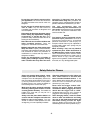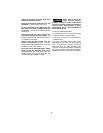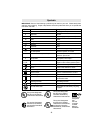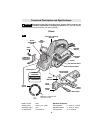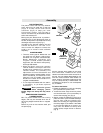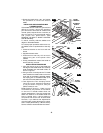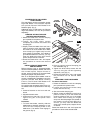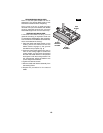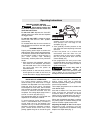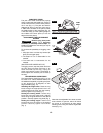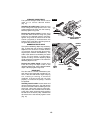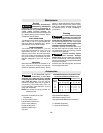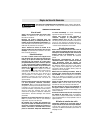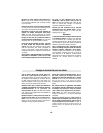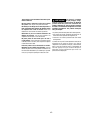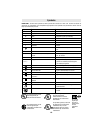
-11-
Operating Instructions
TRIGGER "ON/OFF" SWITCH
Hold the tool with both
hands while starting the
tool, since torque from the motor can
cause the tool to twist.
To turn tool "ON": depress the “Lock-Off”
release button from either side and squeeze
the trigger switch.
To turn the tool "OFF": release the trigger
switch and it will return to "OFF" position
automatically.
To increase switch life, do not turn switch on
and off while tool and drum are held against
a workpiece.
PLANING ACTION
Proper planing action helps to achieve the
desired result. With practice and experience,
it will become second nature. Make sure that
the workpiece is held in place securely on
your work surface, and standing
comfortably, hold the planer firmly with both
hands.
1. With the planer fully adjusted, place the
front shoe on the workpiece, (be certain
that the blade drum is not in contact with
the work) and start the planer as
described earlier.
2. With pressure on the front shoe, and the
fence against the side of the work (to
control the width or angle,) feed the planer
steadily until the full length of the rear
shoe passes over the edge of the
workpiece. (Fig. 10)
3. Then gradually transfer pressure to the
rear shoe, and continue planing to the end
of the cut.
4.Feed the planer at a uniform and
reasonable rate that does not put
excessive strain on the motor or blades,
(do not pull the planer back over the
surface already cut.)
5.Use progressive cuts until you are near
the desired depth, and then re-adjust to a
shallow cut for the final pass to obtain a
good surface finish.
The motor may stall if
improperly used or
overloaded. Reduce the pressure (feed
rate) or depth of cut to prevent possible
damage to the tool if the motor labors.
!
CAUTION
!
WARNING
DEPTH OF CUT & FEED RATE
The cutting depth (planing depth) is
determined by the difference in height
between the adjustable front shoe and the
fixed rear shoe of the planer. The depth
knob adjusts the front shoe, which retracts
and exposes the blade and determines the
amount of material removed from the
workpiece. The cutting depth range is from 0
to 3/32” or 2.6 mm per pass. (Fig. 1)
The appropriate depth of cut and feed rate
depends on the workpiece material:
To avoid clogging and/or damage to the
motor, a more shallow (thin) cut and/or a
slower feed rate may be needed if the
material has any of these characteristics:
hardness; gumminess, sappiness, moisture,
paint, varnish and/or knots. Also, when
planing against the grain or across the grain
rather than with the grain, a shallower cut
and/or slower feed rate is required.
Whenever possible, test by planing a similar
piece of scrap material.
Use multiple, progressive cuts to achieve the
total desired depth.
Start with a shallow cut. If the plane moves
freely through the workpiece with no
excessive load on the motor, the depth
setting can be increased before the next cut.
(Do not change depth of cut while planing.)
When near the desired total depth, re-adjust
the planing depth to a shallow setting for the
final cut to obtain a good surface finish.
Adjusting the Depth of Cut: Rotate depth
adjustment knob clockwise until the
indicator is aligned with the desired cutting
depth on the depth scale (Fig. 1).
FIG. 10
PARK
REST
SHOE



